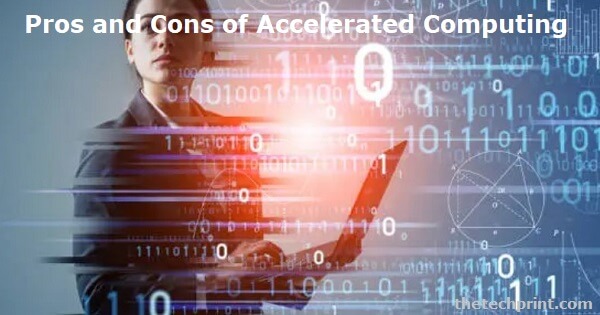As businesses demand robust and increasingly powerful computing solutions, accelerated computing has become viable. Accelerated computing uses specialized hardware to boost the processing power of traditional computers, which can dramatically increase performance for specific tasks. Companies like AMD, NVIDIA, and Intel have all developed platforms that leverage accelerated computing. But as with every technology, there are some limitations you should be aware of beforehand. This guide explores the pros and cons of accelerated computing to help you decide if it’s right for your business.
Accelerated computing uses ICs, GPUs, and other special-purpose processors to speed up computing tasks. This technological approach can significantly reduce the time needed to complete complex tasks, and help you boost efficiency across the board. Some of the leading pros of accelerated computing include the following:
The most apparent benefit of accelerated computing is increased performance. By offloading computationally intensive tasks to specialized hardware, accelerated computing solutions can offer dramatic speed increases compared with traditional software-only approaches. Better performance and efficiency turn out as the major benefits of accelerated computing particularly beneficial when dealing with complex data sets or graphics-heavy workloads.
Accelerated computer solutions can offer significant cost savings by reducing task completion time. This can help businesses cut labor costs and lower their overall IT budget. If you are just entering the gaming market, cost savings can also be among the best advantages of accelerated computing for you.
The scalability provided accelerated systems allow for the addition of powerful processing nodes as needed to handle increased demand or workloads, allowing you to get more out of your existing infrastructure without investing in additional hardware or software. With accelerated computing, there are no restrictions on how much you can scale up and down as your needs change. As your business grows, so can your system’s resources with just the right amount of scaling available.
Accelerated computing can provide faster and more reliable results than traditional processing methods. Using parallelism, multiple threads can work simultaneously on the same data set, reducing the risk that any single line will fail. By combining GPUs with CPUs, accelerated computing systems can produce higher-quality results in less time. That’s how better this technology is compared with traditional processing.
As with any technology, there are potential drawbacks associated with accelerated computing. Some of the main cons of accelerated computing include the following:
Accelerated computing systems can be quite expensive to set up and maintain. In addition to hardware costs, businesses must invest in software licenses and additional IT personnel to manage the system and keep it updated.
The specialized nature of accelerated computing means that some applications may not be compatible with the system or require extensive modifications to work correctly. This can be a significant drawback if your business relies on specific software applications or services.
Deploying an accelerated computing solution can be complex and require a fair amount of technical expertise. With proper configuration, many potential performance benefits may be realized, making acceleration easier to justify from a cost-benefit perspective.
Like any other technology solution, accelerated computing has its own unique security risks. As more sensitive data is processed on specialized hardware, businesses must ensure that their systems are appropriately secured and protected against malicious attacks.
Setting up an accelerated computing system can be complicated and time-consuming since specialized hardware and software are needed to get everything running correctly.
High energy consumption is one of the significant disadvantages of accelerated computing. Accelerated computing requires more powerful CPUs and GPUs, which need more electricity. This increases power costs, especially when running complex computations for extended periods. In addition to monetary costs, increased electricity use also contributes to environmental problems like pollution and global warming.
To minimize energy consumption from accelerated computing, it is essential to ensure your hardware is only running when necessary and that all idle components are powered off whenever possible.
Pros and Cons of Accelerated Computing- Conclusion
As outlined, it could dramatically speed up development time by leveraging dedicated hardware for the user's tasks; however, it can also be expensive and power-hungry. This makes it essential to carefully consider whether or not this type of technology makes sense for your use case.
Ultimately, no matter what application areas you are targeting, if you want to complete tasks as quickly as possible without sacrificing quality or stability, choosing an accelerated computing solution is the right option.
With today's huge variety of options available on both high-end and low-end architectures, deciding whether or not to go with accelerated computing will come down to whatever works most efficiently and cost-effectively for your needs. For a better understanding make sure to go through the Pros and Cons of Accelerated Computing systems beforehand.

Accelerated computing is a contemporary method of computing where the CPU processes the control functionality of an application while a separate acceleration device processes the data-intensive aspects.
GPU acceleration is crucial as it enables computers to enhance the speed of tasks similar to graphical processing—this acceleration results in faster execution of complex computational problems that can be divided into parallel operations.
By implementing clock or power gating techniques, dedicated hardware accelerators can optimize power consumption. This reduces power usage without impacting other processes being executed on the processor.
When playing demanding games, it's normal for your GPU usage to be at 100%. However, your GPU may only need to use some of its resources for less demanding games, resulting in lower GPU usage. Additionally, it's important to avoid keeping your GPU usage at 100% when you're not gaming for long periods because it can cause higher temperatures, more noise, and potentially even a decrease in performance.